HARPERS NEW MONTHLY MAGAZINE
Vol. 93, Issue 556, September, 1896
OLD SILVER
by Theodore S. Woolsey
 Plate I. - American and English Tankards
Plate I. - American and English Tankards |
An old lady who lived on Long Island during the first half of the last century made it her practice - and an admirable practice it was - to put her surplus of butter into one piece of silver every year.
That this taste was not uncommon the old inventories show. Here are a few
items picked almost at random from a couple of town histories in Connecticut:
John Allyn, of New London, died in 1709, leaving a silver tankard, a cup, and
a tumbler.
The estate of Ensign Leffingwell, who died at Norwich in 1724, included three
tankards, two dram-cups, four silver cups - one with two handles.
The widow White of Norwich, 1757, left - reluctantly no doubt - behind her a
silver hair-peg, silver cloak-clasps, a large silver tankard, a silver cup with two handles, another with one handle, a large silver spoon.
At his death, in 1670, Rev. John Davenport owned fifty pounds worth of plate†.
One of his successors, Rev. Mr. Street, in 1674, left a silver drinking-bowl and a silver wine-bowl.
And Governor Eatons estate, in 1656, lists £107 11s, of plate, together with a silver-gilt basin and ewer of Mrs. Eatons.
 Plate II. - Wine Tumblers
Plate II. - Wine Tumblers |
These worthies went to their reward, but their treasures remained in a world where moth and rust do corrupt, and
where thieves too often break through and steal. In course of time they ran an added risk. The temperance movement brought cups and tankards into disrepute; silver forks became the fashion, and the housewife, seizing the opportunity, turned the one into the other - a conversion afterwards bitterly regretted. An unconverted percentage survives to a generation so appreciative as to insist, if it fails to get the real antique, upon at least the semblance of it.
Now there are various learned treatises on old plate which discuss its marks and make and fineness, and give prints of important pieces. But how many of us possess such pieces a mazer of Henry the Sevenths time, a corporation mace, or even a Monteith of the seventeenth century?
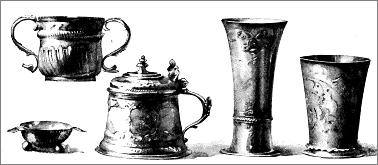 Plate III. - A 16th Century tankard of Breslau manufacture, two German beakers, a London porringer and a salt cellar
Plate III. - A 16th Century tankard of Breslau manufacture, two German beakers, a London porringer and a salt cellar |
What we do see on the sideboards or in the collections of our friends is rarely is figured. Yet this is exactly what we wish to know something about - when and where and by whom the article was made; what it was used for; what its proper name is. The really useful and practical hand-book of domestic plate has yet to be written.
No country has insisted upon so careful and systematic a series of marks upon its plate as Great Britain. There is the stamp of nationality - a lion passant; the "touch" of the various goldsmith companies authorized to stamp silver, for example, the leopard's head in London, or the harp in Dublin; the date letter, which, within limits, gives the year of manufacture; and the makers mark, consisting usually of one or more of his initials. Besides these four, a fifth stamp was required in the important London assay office in 1784, the sovereigns head, which in turn was dropped a few years ago.
The consequence of all this has been to enable English plate to be more certainly identified in respect to date and fineness and origin than any other, and to give it a peculiar value in the eyes of collectors.
NOW there is nothing beautiful in these English hallmarks in themselves; and given the means of ascertaining with equal certainty the make and the age of the plate of other nations, the quality of workmanship, in which French and German and Norwegian silversmiths often surpass the English, is the thing to be considered.
 Plate IV. - Old Caudle Cups
Plate IV. - Old Caudle Cups |
Perhaps an illustration will make what meant clearer. Magdalen College, Oxford, owns some twenty or more English tankards, dating perhaps from 1670 to 1750, and a fine sight they are in the plate-cupboard of the buttery. Among them, or more often in the presidents house, is a larger tankard with a lion thumb-piece, which is justly noteworthy, and listed on the college books as the lion tankard. This piece would bring at auction in London four or five hundred dollars at least. Here are figured (Plate VI.) four Norwegian tankards, each also with a lion thumb-piece, of a similar shape, as early a date, finer workmanship, and more elaborate decoration, which have none of them cost one-quarter of that sum. The silver is not quite so pure in them, and they are not English. That is all there is against them. They make a fine show, are genuine pieces, and are all (dated, either by the letting in of a coin or by a date incised, as well as by the character of the work. The largest will hold half a gallon. Now why should the English tankard be worth as much as all of these put together?
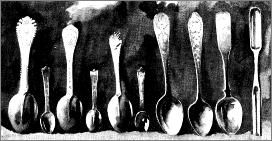 Plate V. - A Century of oval spoons
Plate V. - A Century of oval spoons |
Another tankard is also given here (Plate III.), made in Breslau, in eastern Prussia and dating from the sixteenth century, fully a hundred years older than the others. It is small, but very elegant in shape and design, and of workmanship of a very high order. The same prejudice exists against it, and it would not bring half so much per ounce as an English piece of the same date.
While we are discussing tankards let me call attention to a fact which came out very clearly in the Magdalen buttery. Here are given in a row (Plate I.) several simple tankards of American or English make. The shape of all is very similar, but they differ in their lids. Now by simply noticing the lids it is easy to tell the relative age of tankards of this variety. The rule is this: The flatter the lid, the earlier is the piece. Those figured here vary in date from circa 1670 to 1770. That on the left is the oldest - very flat on top - a fine specimen of American plate. The next, with an additional step in its lid, was made by "KL", whoever he may be. The others, later in date, have rounded lids, with usually an open-work thumb-piece. A fifth example in the same class is given in Plate VIII. This, by its lid, if the rule laid down be correct, should be dated about 1720 - 40. It was therefore both puzzling and annoying to find a year late in the seventeenth century engraved upon it. But on inquiry it appeared that the lid was a restoration, the original one having vanished long since. The restorer had added a shape of lid thirty or forty years too late.
 Plate VI. - Norwegian Tankards
Plate VI. - Norwegian Tankards |
Tankards like these five are plentiful enough. English silversmiths emigrated to this country, and did as good work here as at home. As we learn the names and marks of these men, and can thus identify their work, why is it not, for us at least, as valuable and interesting as any other? What we need is a careful list of such workmen, with their dates and the marks they struck. Mr. Buck has made a beginning at this in his volume on Old Plate, of which an enlarged edition is promised. But it needs a vast amount of work. The town records should be searched on the one hand, and thousands of examples of American-made plate should be catalogued and collated on the other, as Rosenberg has done for Germany.
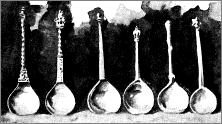
Plate VII. - Dutch & German spoons |
When we are able to identify the makers marks on nine-tenths of the American-made plate treasured in our colonial families thus learning where and between what dates it must have been made, it should have in our eyes a value such as no foreign plate of the same age can boast.
Tankards were not the only drinking-vessels of the last century. The graceful two-handled cup of its first quarter, the wine - tumbler, and the mug of Revolutionary times (Plate VIII.) are also found and, chiefly on the Continent, the beaker.
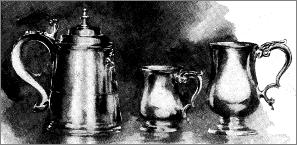 Plate VIII. - The Puzzling Tankard & the Revolutionary Mug
Plate VIII. - The Puzzling Tankard & the Revolutionary Mug |
Here, for instance (Plates IV. and XII.), are figured eight of the first mentioned, technically known as caudle-cups all, save one, made by John Dixwell, of Boston, son of the regicide, and still in use on the communion table of a New England church. They date from 1670 to 1720, or a little later. The wine - tumbler, also called wine - bowl, can still be picked up for no very extravagant sum in Norway or Germany (Plate II.). The distinguishing mark of German plate is an elongated zigzag (vvvvvvv). To this are generally added a city stamp and the makers mark. Thus the Augsburg silversmiths used a pine cone, which indicated the period by its shape. The stamp of Nuremberg was an "N"; of Mayence, a wheel; of Berne, a bear; of Breslau, a "W".
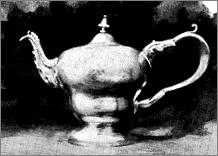
Plate IX. - An early type |
These wine - tumblers are usually silver-gilt. They are not much decorated, having at utmost a delicate engraved border or initials in scroll. A few of different sizes nest very comfortably together in a luncheon-basket, but make no great show in our Plate. They date from 1650 to 1750. The last piece in the row is the English equivalent of these wine-tumblers, with a flat bottom and higher sides, more distinctively a tumbler and less a cup in the modern sense. It was made in Dublin in 1775. Silver tumblers of this shape and of American origin are found here and there. They were occasionally a part of the camp kit of our Revolutionary officers. The beaker was a more important, a more highly decorated vessel. Two are given in Plate III., both of German make the taller one being especially charming in shape and ornamentation; it probably antedates 1600. These beakers are to be preferred to those of a chalice shape with a standard and commonly a cover. This latter form has been widely reproduced in Germany. Tankards have suffered also from this imitation, being even broken and repaired to carry out the deception. Norway is an offender too, and Holland most of all. Probably nine-tenths of the old Dutch toys, trinkets, confit-boxes, and bag clasps which are on sale are brand-new.
The two central pieces in Plate XI. are
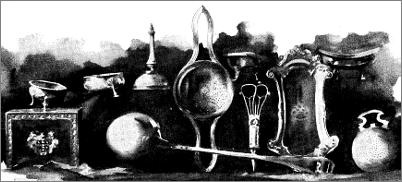 Plate X. - London silver of the last century
Plate X. - London silver of the last century |
what are called in this country porringer, but this is a misnomer. The true porringer is very like a caudle-cup in the two ears or handles and in size, but the sides are straight instead of bellying, and there is usually a cover. A London porringer of 1699, with the fluting characteristic of the article and the period, is figured in the upper part of Plate III. Our so-called porringers are really saucepans for warming a posset on the embers. They may be found in England, though I do not recall one either in the shops or in the South Kensington Museum, which contains a really splendid collection of old English plate and many excellent foreign examples. However, these saucepans are common in this country and make a very graceful and sensible utensil, though the handle must grow hot before the posset does.To avoid this were made sauce pans of other shapes, like the two on the right of Plate XI., the larger being a late London piece with detachable cover; the other, a little thing in repousse, used for warming brandy. The familiar sauce-boat was quite a different thing. Its shape has been much imitated in porcelain. The larger of the two here given, left of Plate XI., was made in New York by Gardiner early in the present century, and can therefore be called old only by courtesy; the other is fifty years earlier, and bears the hallmark of Newcastle-on-Tyne. In the same Plate, in mid-air, is a graceful little cream jug bearing the stamp of P. Revere. The shape is a common one, and has been much reproduced; its peculiarity lies in its solidity, for it must weigh one-half more than the modern imitations.
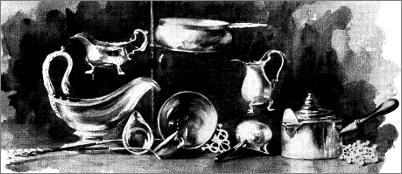
Plate XI. - Sauce-boats and saucepans |
Before leaving this Plate it may be worth while to notice the two little punch-ladles, one oval, the other round but with a nose, and both having, like most of their numerous class, twisted whalebone, handles. These punch-ladles are rarely hall-marked, though often dated by a coin let in, and, so far as my information goes, were seldom made in this country. Very different from these is the ladle in the centre of Plate X., bowl and handle being in the same plane, and the whole heavy enough to brain a burglar with. It has the London date letter of 1729.
The salts and snuffers and tray in the same Plate are not especially noteworthy, though snuffers were commonly of plated ware, and the larger salts stand on four legs instead of the usual tripod, and are probably Italian. The two-handled punch-strainer suggests its uses clearly, and is not a common piece, though of no great age. The tea-caddy on the left, however (London,1781), is a pretty bit, and a good example of the etched decoration so popular during the second half of the last century.
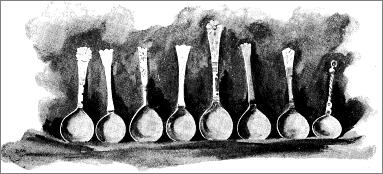 Plate XII. - Norwegian Spoons
Plate XII. - Norwegian Spoons |
Three Plates of spoons are given (V., VII., and XII.), for the subject is an interesting one. Two centuries are represented, the seventeenth and eighteenth. Of course the round-bowl spoon belongs to the earlier. Plate XII. represents Norwegian spoons exclusively; those in VII. are Dutch and German. No difference in shape of bowl appears between the makes of different nations, but the Norwegian spoons usually have a fiat handle with etched ornament, while the German stems are solider and rounder, depending upon their form, and not upon the engraver, for effect.
Horn bowls with a silver handle riveted on were common. More rarely handle and bowl, though both of silver, were made separately, and then fastened, while in the next century this practice became usual.
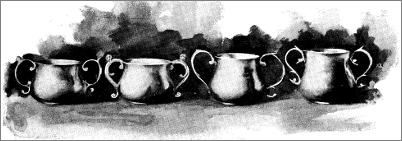
Plate XIII. - Caudle cups now in use as communion cups |
Roughly speaking, the year 1700 is the dividing-line between the round and the oval bowl. Plate V. shows a century of the latter, from about 1710 to 1810. During the first half of this period the distinguishing features were a broader handle, often slit at the end, a bowl more nearly ellipsoid than oval, and the ridge of union between bowl and handle, which is commonly known as a rat-tail. This doubtless sprang from the practice alluded to of welding or riveting the parts together, but survived in a rudimentary state after the spoon was commonly made one solid whole. It is still often employed as a shoulder to strengthen the point of union, the tail being abbreviated. During the latter half of the century the bowl became a pure oval, the handle usually being decorated with the etched ornament characteristic of the period.
 Plate XIV. - Eighteenth Century Silver
Plate XIV. - Eighteenth Century Silver |
This same ornament is shown on the salver in Plate XIV. and the tea-caddy, Plate X. The last article on Plate V. is an old English marrow-spoon, the narrow bowl of which is also found in combination with an oval one.
Three bowls only are figured here, Plates XIV. and XV., but they are sufficiently common, and with a great variety of decoration, to which this shape lends itself. Except for its ears, one of those in Plate XIV., however, is entirely plain. Its lack of a foot or stand would seem to indicate a good deal more age than have the others, which date from 1780 to 1790. All are of American workmanship.
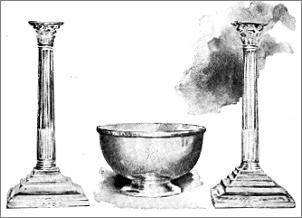
Plate XV. - London Candlesticks |
Candlesticks, like snuffers, are commonly plated, but those in Plate XV. are of London make and mark, and well executed. They lack, however, a broader detachable top, or bobeche, which has been stolen. Plate XVI. figures a bread - basket (London, 1737). This is a very perfect and fine example of the cut silver so popular in England in the middle of the last century, when Paul Lamerie flourished. A companion piece to this basket, made ten years later for the wife of Governor Hancock, of Boston, is in the hands of a connection of that family. This form of decoration, simple in itself, but producing effects of great richness, was much used in flat articles like trays and salvers, and has been deservedly revived.
The tea service and coffee-pot of our great-grandmothers time are so familiar that no examples have been given. The common shapes are round, or oblong with rounded corners; the decoration of infinite variety; stands are usual, and the handles of the pots are either of ebony, or of silver insulated by a ring of bone let in.
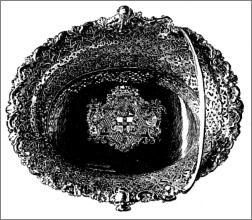 Plate XVI. - An old bread basket
Plate XVI. - An old bread basket |
On Plate IX. is given a teapot of an earlier type, which in shape and balance and feeling is quite the ideal of what an ancestral teapot should be. On the last of our Plates is grouped a lot of clasps framed in by a silver chain or girdle. The objects on the right are cloak or belt clasps, and, except one, are Norwegian; those on the left are book clasps and German. In the centre is that rara avis a genuine Dutch bag clasp. Such articles as these, trivial in themselves, but each with an individuality, an original note of its own, may still be found in the shops of the silversmiths abroad, brought in for sale or exchange. They lend a pleasant touch to a woman's costume or a fine old binding, and it is always more satisfactory to buy in this way than from the dealers in antiquities.
The communion plate in many of the older churches in this country is of considerable age and interest, but has been already elsewhere figured and discussed.* It is referred to here only to call attention to one fact. In the Episcopal churches the conventional shapes of chalice, paten, and flagon were quite strictly adhered to. On the contrary, in New England one may still see in use in many of the older non-Episcopal houses of worship the domestic drinking - vessels of the past; tankards, caudle - cups, tumblers. By gift or bequest they came straight from secular to sacramental use from the table of the giver to the table of the Lord. This disregard of the conventionalism of the Church of England and its derivative, this protest against its forms, is characteristic and interesting.
* Old Plate. J. H. Buck. 1888. The Gorham Manufacturing Company.
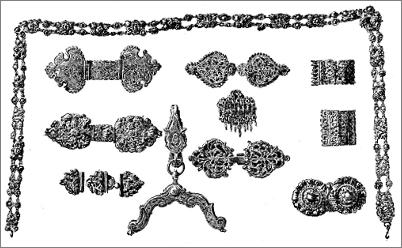
Plate XVII. - Old silver clasps |
Besides articles in which silver is the sole constituent, it enters into the decoration or composition of many others which the fancier prizes. The mounting of an old table - knife, dagger, or sword, the inlaid-work on a Spanish bit, combinations with wood, with ivory, with other metals, illustrate how excellent a thing it is in the arts. This kind of bimetallism is entirely harmless.
There are two remarks with which this very cursory study of the domestic plate of two centuries may he appropriately closed. The one is addressed to the collector. Old silver has a color, a touch, a feeling, peculiar to itself. The genuineness of a piece must he determined by a study of these points, as well as of the style, the marks of wear, and the history. It is only by the examination, the handling if possible, of a large number of specimens that one can gain accurate knowledge of these qualities. The second remark is a deduction from the first. Such examination can only he possible where collections, permanent or temporary, are exposed to view. Rosenberg, already alluded to, has made his admirable study of the old silver of his father-land by taking advantage of the large loan exhibitions of such articles which have been held within the past fifteen years at Amsterdam, Augsburg, Brussels, Karlsruhe, Nuremberg, St. Petersburg, Buda - Pesth, Vienna, and Zurich, as well as of royal and private collections. His ten thousand examples have furnished two thousand marks. This will indicate how alone a satisfactory history of old American plate and its makers can be made. The older centres, under proper precautions, could gather all available material by loan, and allow access to it to competent persons. The amount of old American-made plate in existence is probably larger than any one but the careful student of early inventories would credit. A proper history of such plate, its marks and its makers would give it a historical, artistic, and commercial value which must always otherwise be lacking.
•
Theodore Salisbury Woolsey (1852 - 1929)
Professor of international law, Yale, 1878-1911. Born in New Haven, CT, October 22, 1852. Graduated from Yale, 1872 (A. M., 1877); Yale Law School, 1876; LL. D., Brown University, 1903. Instructor of public law, Yale, 1877. Editor: "Woolsey's International Law," "Pomeroy's International Law." Author: "America's Foreign Policy." Also many articles in magazines and journals.
•
† (note: The use of the word "plate" in this article does not refer to silverplate, but is the archaic form meaning solid silver: Domestic vessels and utensils, as flagons, dishes, cups, etc., wrought in gold or silver.
[1913 Webster's Revised Unabridged Dictionary] )
|
